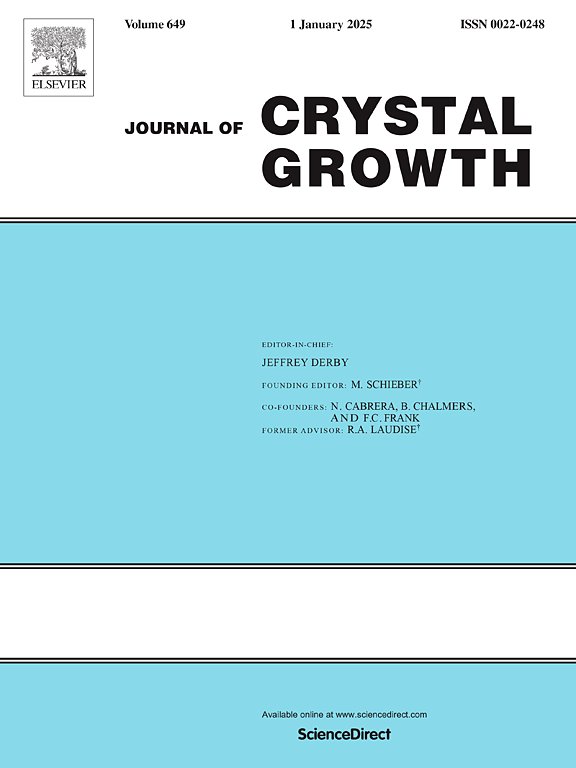Investigation of the effect of the flow rate of coolant on the kinetics of carbon dioxide hydrate growth using sigmoidal growth model
IF 1.7
4区 材料科学
Q3 CRYSTALLOGRAPHY
引用次数: 0
Abstract
Relaxation time plays a crucial role in studying reaction kinetics and other processes. This study addresses the importance of relaxation time and suggests methods to minimize it. In this article, we adjust the relaxation time by extracting heat from the hydrate formation process through variations in the flow rate of the cooling fluid. It has been demonstrated that heat transfer plays a dominant role in this process. The kinetics of carbon dioxide hydrate growth were evaluated by increasing the flow rate of cooling fluid using modified sigmoidal growth curve equations, including Logistics and Gompertz. It was conducted a nonlinear least-squares regression analysis to fit sigmoidal functions to the cumulative formation curves of hydrate generated from gas uptake in the static reactor over time. The percentage of error between Areal and Amodel shows that the Gompertz model with Q = 14.59 Lit/min at T = 276 K and Q = 20.25 Lit/min at T = 277 K is the best model for predicting the maximum consumption capacity of CO2. The results also showed that increasing the cooling fluid’s flow rate reduces relaxation time at any temperature. Moreover, increasing the flow rate of the cooling fluid decreased the average relaxation time by 2 % to 60 % at T = 276 K and by 7 % to 22 % at T = 277 K compared to the lowest investigated flow rate. Additionally, reducing the experimental temperature while keeping the flow rate of the cooling fluid constant led to a reduction in the relaxation time.
利用曲线生长模型研究冷却剂流速对二氧化碳水合物生长动力学的影响
弛豫时间在研究反应动力学和其他过程中起着至关重要的作用。本研究探讨了弛豫时间的重要性,并提出了尽量缩短弛豫时间的方法。在本文中,我们通过改变冷却液的流速从水合物形成过程中提取热量来调整弛豫时间。事实证明,热传递在这一过程中起着主导作用。通过增加冷却流体的流速,使用修正的西格码增长曲线方程(包括 Logistics 和 Gompertz)评估了二氧化碳水合物的增长动力学。进行了非线性最小二乘回归分析,以拟合静态反应器中气体吸收产生的水合物随时间变化的累积形成曲线的 sigmoidal 函数。Areal 与 Amodel 之间的误差百分比表明,Gompertz 模型在 T = 276 K 时 Q = 14.59 升/分钟,在 T = 277 K 时 Q = 20.25 升/分钟,是预测二氧化碳最大消耗能力的最佳模型。结果还表明,提高冷却液的流速可缩短任何温度下的弛豫时间。此外,与最低研究流速相比,增加冷却液流速可使平均弛豫时间在 T = 276 K 时缩短 2 % 至 60 %,在 T = 277 K 时缩短 7 % 至 22 %。此外,在保持冷却液流速不变的情况下降低实验温度也会导致弛豫时间缩短。
本文章由计算机程序翻译,如有差异,请以英文原文为准。
求助全文
约1分钟内获得全文
求助全文
来源期刊

Journal of Crystal Growth
化学-晶体学
CiteScore
3.60
自引率
11.10%
发文量
373
审稿时长
65 days
期刊介绍:
The journal offers a common reference and publication source for workers engaged in research on the experimental and theoretical aspects of crystal growth and its applications, e.g. in devices. Experimental and theoretical contributions are published in the following fields: theory of nucleation and growth, molecular kinetics and transport phenomena, crystallization in viscous media such as polymers and glasses; crystal growth of metals, minerals, semiconductors, superconductors, magnetics, inorganic, organic and biological substances in bulk or as thin films; molecular beam epitaxy, chemical vapor deposition, growth of III-V and II-VI and other semiconductors; characterization of single crystals by physical and chemical methods; apparatus, instrumentation and techniques for crystal growth, and purification methods; multilayer heterostructures and their characterisation with an emphasis on crystal growth and epitaxial aspects of electronic materials. A special feature of the journal is the periodic inclusion of proceedings of symposia and conferences on relevant aspects of crystal growth.
 求助内容:
求助内容: 应助结果提醒方式:
应助结果提醒方式:


